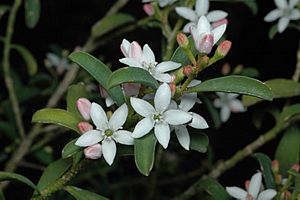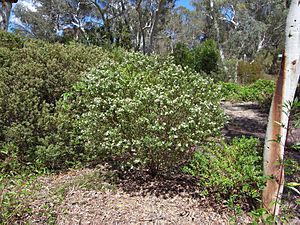Philotheca myoporoides subsp. acuta facts for kids
Quick facts for kids Philotheca myoporoides subsp. acuta |
|
|---|---|
 |
|
| In the Australian National Botanic Gardens | |
| Scientific classification |
|
| Kingdom: | Plantae |
| Clade: | Tracheophytes |
| Clade: | Angiosperms |
| Clade: | Eudicots |
| Clade: | Rosids |
| Order: | Sapindales |
| Family: | Rutaceae |
| Genus: | Philotheca |
| Species: | |
| Subspecies: |
P. m. subsp. acuta
|
| Trinomial name | |
| Philotheca myoporoides subsp. acuta (DC.) Bayly
|
|
| Synonyms | |
|
|
Philotheca myoporoides subsp. acuta is a type of flowering plant that belongs to the Rutaceae family. This family also includes citrus fruits like oranges and lemons! This plant is a shrub that only grows naturally in New South Wales, Australia. It has long, thin leaves and pretty white flowers that grow alone or in small groups where the leaves meet the stem.
Contents
What Does This Plant Look Like?
Philotheca myoporoides subsp. acuta is a shrub that usually grows to be about 1.8 to 2 meters (about 6 to 6.5 feet) tall. Its stems are smooth and have many small, raised bumps that look like tiny glands.
Leaves and Flowers
The leaves of this plant are directly attached to the stem, meaning they don't have a small stalk. They are shaped like a narrow oval or ellipse, sometimes even like a spear with the narrow end at the base. Each leaf is about 25 to 40 millimeters (1 to 1.5 inches) long and 4 to 8 millimeters (about 0.15 to 0.3 inches) wide. They also have a tiny point at the very tip.
The white flowers grow either by themselves or in small groups of two or three. They appear where the leaves join the stem. Each group of flowers grows on a small stalk called a peduncle, which is up to 5 millimeters long. Each individual flower then has its own tiny stem, called a pedicel, that is 1 to 10 millimeters long. The petals of the flowers are broadly oval-shaped and about 8 millimeters long. They have a noticeable ridge down the middle, which is called a keel. This plant mostly blooms in spring and autumn.
How This Plant Got Its Name
This specific plant was first officially described in 1941 by a person named William Blakely. He gave it the name Eriostemon myoporoides var. acutus. He wrote about it in a scientific journal called Contributions from the New South Wales Herbarium.
Later, in 1998, another scientist named Michael James Bayly changed its name to Philotheca myoporoides subsp. acuta. This new name was published in a journal called Muelleria.
Where Does It Grow?
This special type of plant grows on rocky hills made of sandstone. You can find it mainly in the southern central parts of New South Wales, Australia. Its range stretches from a town called Lockhart down to the area south of Cobar.


